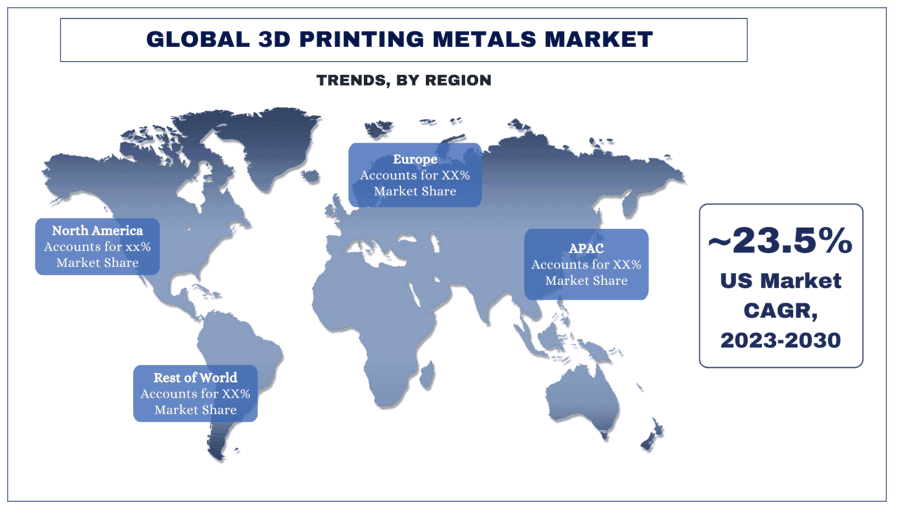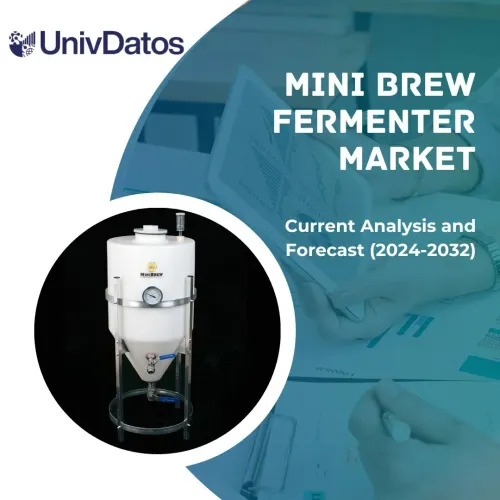
3D 프린팅 금속 시장은 예측 기간 동안 3D 프린팅 기술의 발전으로 인해 빠른 인쇄 속도, 더 높은 해상도, 금속 부품의 더 나은 재료 특성이 나타나면서 약 23.5%의 강력한 CAGR로 성장할 것으로 예상됩니다. 3D 프린팅 금속의 이러한 모든 요소는 전통적인 제조 기술과 경쟁력을 갖추게 했습니다. 항공우주 산업은 항공기 및 우주선을 위한 경량 및 고강도 부품에 대한 끊임없는 필요성으로 인해 주요 동인입니다. 3D 프린팅은 복잡한 격자 구조 및 설계 최적화를 통해 무게를 줄이고 연료 효율성을 향상시킵니다. 또한, 더 나은 연비와 전기 자동차 부품을 위한 더 가벼운 차량에 대한 수요가 브래킷, 열교환기, 심지어 구조 부품과 같은 부품에 3D 프린팅 금속을 사용하게 합니다.
시장에서 활동하는 주요 업체로는 Jiangxi Copper Corporation, BHP, Caterpillar, Anglo American, VALE S.A, WIRTGEN GROUP, First Quantum Minerals Ltd, Lundin Mining Corporation, Ma’aden 및 Exxaro가 있습니다. 여러 M&A와 파트너십이 이러한 업체에 의해 수행되어 고객에게 첨단 혁신적인 제품/기술을 제공합니다.
보고서에 제시된 통찰력
“기술 중 알루미늄 부문이 2022년에 상당한 성장을 보였습니다.”
기술을 기준으로 시장은 티타늄, 니켈, 스테인리스강, 알루미늄 등으로 분류됩니다. 이 중 알루미늄의 경제성, 인쇄성 및 귀중한 특성으로 인해 알루미늄 부문은 3D 프린팅 금속 시장에서 상당한 점유율을 차지하고 있습니다. 기술 발전이 진행됨에 따라 새로운 합금이 등장하고 있으며, 알루미늄은 이 성장 분야에서 상당한 점유율을 유지할 가능성이 높습니다. 또한 알루미늄은 우수한 흐름 특성과 낮은 융점으로 인해 다른 금속에 비해 인쇄가 더 쉬운 금속이며, 이는 더 부드러운 인쇄 프로세스를 가능하게 하고 균열 또는 뒤틀림과 같은 결함의 가능성을 줄입니다.
“응용 분야 중 항공우주 및 방위 부문이 시장에서 상당한 성장을 보였습니다.”
응용 분야를 기준으로 시장은 자동차, 항공우주 및 방위, 의료, 가전 제품, 전력 및 에너지 등으로 분류됩니다. 이 중 항공우주 및 방위 부문은 3D 프린팅 금속 시장에서 상당한 점유율을 차지하고 있습니다. 기존의 제조 방법은 종종 A&D 부품의 설계 가능성을 제한하지만 3D 프린팅 금속은 타의 추종을 불허하는 설계 자유도를 제공하여 다른 기술로는 불가능한 복잡한 기하학적 구조와 내부 구조를 엔지니어링할 수 있습니다. 또한 A&D 산업은 새로운 기술을 배치하기 전에 철저한 프로토타입 제작 및 테스트 주기에 크게 의존합니다. 3D 프린팅 금속을 사용하면 기능적인 금속 프로토타입을 빠르게 생성할 수 있어 설계 반복 프로세스를 가속화하고 새로운 항공기 및 우주선 모델을 더 빠르게 개발할 수 있습니다.
3D 프린팅 금속 시장 세분화

“북미는 2022년 3D 프린팅 금속 시장에서 상당한 점유율을 차지하고 있습니다.”
특히 미국을 포함한 북미는 조기 채택으로 인해 3D 프린팅 기술 개발의 최전선에 있었으며, 이는 3D 프린팅 금속 기계 및 재료의 선도적인 제조업체, 3D 프린팅 기술 전문 지식을 갖춘 숙련된 인력, 3D 프린팅 연구 개발에 적극적으로 참여하는 연구 기관 및 대학을 포함하는 강력한 인프라 구축으로 이어졌습니다. 또한 북미는 항공우주, 자동차, 의료 기기를 포함한 다양한 산업 분야의 기업이 혁신적인 제조 솔루션을 끊임없이 모색하고 있기 때문에 잘 확립되고 다양한 제조 부문을 자랑합니다. 3D 프린팅 금속은 설계 자유도, 경량 부품, 빠른 프로토타입 제작과 같은 이점을 제공하여 이러한 산업에 매력적인 옵션이 됩니다. 더욱이 북미는 3D 프린팅 기술 발전의 중심지입니다. 선도적인 기업과 연구 기관은 지속적으로 새롭고 개선된 3D 프린팅 금속 기술을 개발하여 시장을 더욱 발전시키고 있습니다.
3D 프린팅 금속 시장 동향

3D 프린팅 금속 시장 보고서 범위

이 보고서를 구매해야 하는 이유:
- 이 연구에는 인증된 주요 산업 전문가가 검증한 시장 규모 및 예측 분석이 포함되어 있습니다.
- 이 보고서는 전체 산업 성과에 대한 빠른 검토를 한눈에 제공합니다.
- 이 보고서는 주요 비즈니스 재무, 제품 포트폴리오, 확장 전략 및 최근 개발에 중점을 두고 주요 산업 동료에 대한 심층 분석을 다룹니다.
- 산업 전반에 걸쳐 존재하는 동인, 제약, 주요 동향 및 기회에 대한 자세한 조사.
- 이 연구는 다양한 세그먼트에서 시장을 포괄적으로 다룹니다.
- 산업에 대한 심층적인 지역 수준 분석.
사용자 정의 옵션:
글로벌 3D 프린팅 금속 시장은 요구 사항 또는 기타 시장 세그먼트에 따라 추가로 사용자 정의할 수 있습니다. 이 외에도 UMI는 귀하가 고유한 비즈니스 요구 사항을 가질 수 있음을 이해하므로 귀하의 요구 사항에 완벽하게 맞는 보고서를 얻으려면 주저하지 말고 당사에 문의하십시오.
목차
3D 프린팅 금속 시장 분석을 위한 연구 방법론(2022-2030)
글로벌 3D 프린팅 금속 시장의 과거 시장 분석, 현재 시장 추정, 미래 시장 예측은 전 세계 주요 지역에서 3D 프린팅 금속 채택을 분석하고 평가하기 위해 수행된 세 가지 주요 단계였습니다. 과거 시장 데이터를 수집하고 현재 시장 규모를 추정하기 위해 철저한 2차 연구가 수행되었습니다. 둘째, 이러한 통찰력을 검증하기 위해 수많은 조사 결과와 가정이 고려되었습니다. 또한 글로벌 3D 프린팅 금속 시장의 가치 사슬 전반에 걸쳐 업계 전문가들과 심층적인 1차 인터뷰도 진행되었습니다. 1차 인터뷰를 통해 시장 데이터를 가정하고 검증한 후, 전체 시장 규모를 예측하기 위해 하향식/상향식 접근 방식을 사용했습니다. 이후, 산업에 관련된 세분 시장 및 하위 세분 시장의 시장 규모를 추정하고 분석하기 위해 시장 세분화 및 데이터 삼각 측정 방법을 채택했습니다. 자세한 방법론은 아래에 설명되어 있습니다.
과거 시장 규모 분석
1단계: 2차 출처 심층 연구:
연례 보고서 및 재무제표, 실적 발표, 보도 자료 등과 같은 회사 내부 자료와 저널, 뉴스 및 기사, 정부 간행물, 경쟁사 간행물, 부문 보고서, 제3자 데이터베이스 및 기타 신뢰할 수 있는 간행물을 포함한 외부 자료를 통해 3D 프린팅 금속 시장의 과거 시장 규모를 파악하기 위해 상세한 2차 연구를 수행했습니다.
2단계: 시장 세분화:
3D 프린팅 금속 시장의 과거 시장 규모를 파악한 후, 주요 지역의 다양한 세분 시장 및 하위 세분 시장에 대한 과거 시장 통찰력과 점유율을 수집하기 위해 상세한 2차 분석을 수행했습니다. 주요 세분 시장에는 형태, 금속 유형, 최종 사용자와 같은 보고서에 포함된 내용이 있습니다. 또한 해당 지역의 테스트 모델의 전반적인 채택을 평가하기 위해 국가 수준의 분석을 수행했습니다.
3단계: 요인 분석:
다양한 세분 시장 및 하위 세분 시장의 과거 시장 규모를 획득한 후, 3D 프린팅 금속 시장의 현재 시장 규모를 추정하기 위해 상세한 요인 분석을 수행했습니다. 또한 재생 에너지에 대한 수요 증가와 같은 종속 및 독립 변수를 사용하여 요인 분석을 수행했습니다. 전 세계 3D 프린팅 금속 시장 부문에서 최고의 파트너십, 합병 및 인수, 사업 확장 및 제품 출시를 고려하여 수요 및 공급 측면 시나리오에 대한 철저한 분석을 수행했습니다.
현재 시장 규모 추정 및 예측
현재 시장 규모 측정: 위의 3단계에서 얻은 실행 가능한 통찰력을 바탕으로 글로벌 3D 프린팅 금속 시장의 현재 시장 규모, 주요 업체 및 세분 시장의 시장 점유율을 파악했습니다. 위에 언급된 2차 접근 방식을 사용하여 필요한 모든 비율 점유율 분할 및 시장 세분화를 결정했으며, 1차 인터뷰를 통해 검증했습니다.
추정 및 예측: 시장 추정 및 예측을 위해 동인 및 추세, 제약 및 이해 관계자가 이용할 수 있는 기회를 포함한 다양한 요인에 가중치를 할당했습니다. 이러한 요인을 분석한 후 관련 예측 기술, 즉 하향식/상향식 접근 방식을 적용하여 전 세계 주요 시장의 다양한 세분 시장 및 하위 세분 시장에 대한 2028년 시장 예측에 도달했습니다. 시장 규모를 추정하기 위해 채택된 연구 방법론은 다음과 같습니다.
- 주요 시장 전반에 걸쳐 수익(USD) 측면에서 산업의 시장 규모와 3D 프린팅 금속 시장의 채택률.
- 시장 세분 시장 및 하위 세분 시장의 모든 비율 점유율, 분할 및 세분화
- 제공되는 제품 측면에서 글로벌 3D 프린팅 금속 시장의 주요 업체. 또한 빠르게 성장하는 시장에서 경쟁하기 위해 이러한 업체들이 채택한 성장 전략.
시장 규모 및 점유율 검증
1차 연구: 주요 지역 전반에 걸쳐 최고 경영진(CXO/VP, 영업 책임자, 마케팅 책임자, 운영 책임자, 지역 책임자, 국가 책임자 등)을 포함한 핵심 오피니언 리더(KOL)와 심층 인터뷰를 진행했습니다. 그런 다음 1차 연구 결과를 요약하고, 명시된 가설을 입증하기 위해 통계 분석을 수행했습니다. 1차 연구에서 얻은 입력은 2차 결과와 통합되어 정보를 실행 가능한 통찰력으로 전환했습니다.
다양한 지역에서 1차 참가자 분할

시장 엔지니어링
글로벌 3D 프린팅 금속 시장의 각 세분 시장 및 하위 세분 시장에 대한 정확한 통계 수치를 도출하고 전반적인 시장 추정을 완료하기 위해 데이터 삼각 측정 기술을 사용했습니다. 글로벌 3D 프린팅 금속 시장에서 차량 유형 및 기술 분야의 다양한 매개 변수와 추세를 연구한 후 데이터를 여러 세분 시장 및 하위 세분 시장으로 분할했습니다.
글로벌 3D 프린팅 금속 시장 연구의 주요 목표
글로벌 3D 프린팅 금속 시장의 현재 및 미래 시장 추세가 연구에서 정확히 지적되었습니다. 투자자는 연구에서 수행된 질적 및 양적 분석에 대한 재량에 따라 투자할 수 있는 전략적 통찰력을 얻을 수 있습니다. 현재 및 미래 시장 추세는 지역 수준에서 시장의 전반적인 매력도를 결정하여 산업 참가자가 미개척 시장을 활용하여 선점자 이점을 누릴 수 있는 플랫폼을 제공했습니다. 연구의 다른 양적 목표는 다음과 같습니다.
- 가치(USD) 측면에서 3D 프린팅 금속 시장의 현재 및 예측 시장 규모를 분석합니다. 또한 다양한 세분 시장 및 하위 세분 시장의 현재 및 예측 시장 규모를 분석합니다.
- 연구의 세분 시장에는 형태, 금속 유형 및 최종 사용자와 같은 영역이 포함됩니다.
- 3D 프린팅 금속에 대한 규제 프레임워크를 정의하고 분석합니다.
- 다양한 중개인의 존재와 관련된 가치 사슬을 분석하는 것과 함께 산업의 고객 및 경쟁업체 행동을 분석합니다.
- 주요 지역의 3D 프린팅 금속 시장에 대한 현재 및 예측 시장 규모를 분석합니다.
- 보고서에서 연구된 지역의 주요 국가에는 아시아 태평양, 유럽, 북미 및 기타 지역이 포함됩니다.
- 3D 프린팅 금속 시장의 회사 프로필과 시장 참가자가 빠르게 성장하는 시장에서 지속하기 위해 채택한 성장 전략.
- 산업에 대한 심층적인 지역 수준 분석.
자주 묻는 질문 자주 묻는 질문
Q1: 전 세계 3D 프린팅 금속 시장의 현재 시장 규모와 성장 잠재력은 무엇입니까?
Q2: 전 세계 3D 프린팅 금속 시장 성장의 주요 동인은 무엇입니까?
Q3: 형태별 글로벌 3D 프린팅 금속 시장에서 가장 큰 점유율을 차지하는 부문은 무엇입니까?
Q4: 글로벌 3D 프린팅 금속 시장에서 어느 지역이 상당한 성장을 보일 것으로 예상됩니까?
Q5: 글로벌 3D 프린팅 금속 시장에서 활동하는 주요 기업은 어디인가요?
관련 보고서
이 상품을 구매한 고객님들도 함께 구매하신 상품










